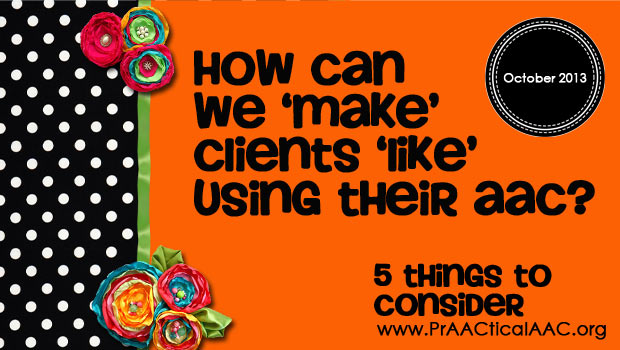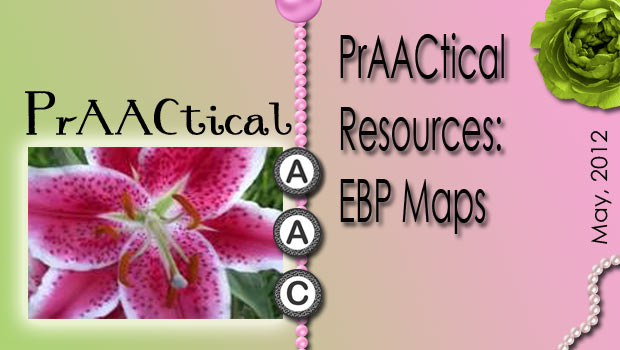How Can We Make Clients ‘Like’ Using Their AAC? 5 Things to Consider

That’s a question we hear from time to time, and it often stops us in our tracks. The good thing about this question is that is signals that the clinician recognizes a stumbling block and is searching for a way around it. Like many things in our lives as SLPs, it’s all about problem-solving.
So, how DO you make learners like their AAC?
Well, for starters, we don’t like ‘making’ people do anything. Offer, entice, tempt? Yes, frequently. ‘Make’? Not our first, second, or third choice. If we have a really strong rationale and we’ve run out of other options, we may go there. When it comes to helping our clients learn to like their AAC systems, here are some things we think about.
here are some things we think about.
1. We like what we’re good at: Until someone is proficient at aspects of their AAC system, it will feel like work. Why? Because it is hard! When things are effortful, we tend not to like them unless the payoff for that activity exceeds the level of effort.
2. We like what we like: To what extent is the client’s personality or particular interests reflected in the AAC? How well do the vocabulary and messages allow the communicator to say what he/she wants to say? While we often think that we did a good job with this, sometimes it can help to take a step back and look at the communication aid objectively. It helps to ask, “What can I do to make the AAC more appealing?” Maybe it’s some pre-stored messages that allow the communicator to tease, show off, or amuse others. Maybe we can add some symbols for special people, favorite places, or special events. Maybe we need to make it more aesthetically pleasing. Can we make it more appealing with a favorite theme, like Hello Kitty, super heroes, or sports? Sometimes, little tweaks can make a big difference.
3. We like things that make us feel successful: Sometimes we’re not really good at something, but the experience makes us FEEL successful. So, when the session/lesson/activity is over, we try to ask ourselves, “How did that make the learner feel?” If the answer is good, competent, successful, proud, or something along those lines, then it’s a lesson we might keep or repeat. If not, then it’s time for a post-mortem analysis. What went wrong? What could I do differently next time so the learner leaves feeling good about him/her self?
4. When the benefit of something we don’t like is clear and important to us, we dislike it less: Going to the dentist? Not our favorite way to spend an hour. But we all go. Why? Because we know that if we do, we can avoid big problems later on. Getting someone to ‘like something’ may be a process that is best addressed in stages. For a client who really doesn’t care to use their AAC, it’s a real stretch to get to ‘like.’ Maybe the first step is to get them to tolerate it and dislike it less. With some AAC learners it can help to have metalinguistic conversations to help them connect what they dislike or resist (the AAC) and things they want for themselves. “Julian, I know this is hard. But every time you do it, it helps you get faster. And that makes it easier to tell your friends that you want a turn.” “Arielle, if you keep doing this, Ms. P is going to be so surprised when you tell her the answer!” ‘Marshall, when you used your ___ to talk to Jonah, he stayed and showed you his pictures from the weekend. That’s pretty cool!”
5. We like being recognized: How great does it feel when a parent sends a note to your boss telling about how you’ve helped their child? Isn’t it meaningful when you overhear a colleague telling the team how much she counts on you? People learning AAC like that same kind of authentic recognition. So, don’t be shy about bragging about your clients’ authentic achievements. Catch them doing well. Share it loudly and proudly. Talk about it, write about it, send notes home. “Mrs. P, ask Jonah about ___. He rocked it!” “Tommy, we need to let your mom and dad know about this. Let’s write them a note, okay?” “That was very helpful, Marissa. I think we need a Character Counts point for that!”
As SLPs, we all work so very hard to get the learner access to appropriate AAC tools, program devices, make visual supports, write meaningful goals, provide research-supported intervention, get buy-in from the team, and support carryover at home, school and in the community. We put a lot of ourselves into each of these situations. There’s no denying that it stings when someone tells us that the client doesn’t like their AAC. It’s okay to feel a little wounded, but we have to train ourselves to take a breath, look past that, and keep going. It reminds me of that donkey story, the one who fell into an abandoned well. And so, we shake it off and step up. We sigh. We shake it off (again) and step up. The process can be slow, dirty, and frustrating, but sometimes, it’s the only way up.
Filed under: PrAACtical Thinking
Tagged With: client perspective, client-centered
This post was written by Carole Zangari

